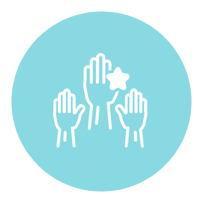Throughout my work as a teacher and then for years in educational technology, eventually, as the Vice President of Customer Success in the education division for a Fortune 500 education company, I lived and breathed education pilots and implementations for many years. I would find myself debriefing with my colleagues daily, discussing how we could improve pilots and implementations around the country. During these years, I trained my team, primarily comprised of former classroom teachers, to look deeply at each district’s and school’s protocols utilized during implementation.
My team learned to conduct weekly risk analyses and highlight schools in jeopardy of not successfully implementing their new pilot or fully implementing an educational solution. When we found schools or districts dealing with roadblocks, we would create mitigations and provide extra “TLC” to get them through their “pilot” or “initial implementation phase.”

After years of managing teams through these experiences, I can affirmatively state the obvious conclusion that all schools and districts know to be true:
Pilots and all new implementations can be difficult; unfortunately, they will fail if planning and preparation are insufficient.
The Goal of This Article is to Provide MTSS Best Practices to Help Schools and Districts Identify Potential Pitfalls When Implementing MTSS
It is important to note that the goal of this article is not to provide a “doom and gloom” perspective regarding pilots or initial implementations as schools work to add new initiatives. Instead, I am writing to provide best practices to help schools and districts identify potential pitfalls within their pilots or new implementations, specifically when implementing a Multi-Tiered System of Supports (MTSS).
MTSS is a collaborative system of supports that wraps around an entire school. As a system-level structure, MTSS provides academic, behavioral, social-emotional, and attendance support for all students. Therefore, it is critical to identify and understand the pitfalls districts and schools may face when piloting or implementing MTSS protocols so risks are mitigated so all students can experience the powerful and supportive systems MTSS provides.
Below, please find the most common pitfalls I have found throughout my work (and what to do about them) to ensure your MTSS pilots and new implementations are on the road to success.
Pitfall #1: Not Providing an In-Depth Explanation of the “Why” and the Goal(s) of New Implementation to All Stakeholders
The writer Robin Sharma tweeted his thoughts about change a few years ago. He said, “Change is hardest at the beginning, messiest in the middle, and best at the end.” Sometimes, when we ask teachers to change or add to their practices, such as taking on a new pilot or implementation, it can be hard (and messy). This is potentially due to our first most common pitfall—not providing an in-depth explanation of the “why” change is needed and the goals of the new protocols, leaving teachers to ask, “Why bother?”.
What To Do Instead
 To avoid this pitfall, ensure:
To avoid this pitfall, ensure:
- The goal of MTSS, to provide academic, behavioral, social-emotional, and attendance support for all students, is understood by all stakeholders.
- The “basics” of MTSS, such as key terminology, have been outlined to reduce the risk of miscommunications.
- The systems of MTSS are understood, such as listed in the MTSS flowchart, to provide the “big picture.”
- Frequent communication and touch base often. Provide reminders regularly of the above bullets, and meet one-on-one with those having difficulty with the change.
|
Related Resources: |
Pitfall #2: Not Dedicating Enough Time For Robust Professional Development Before New Implementation Begins
How often have the following sentiments been heard throughout your school hallways or district offices?
“I don’t have time for this meeting.”; or
“I do not have time for another PD!”; and
“I could attend this informational session if I had more time…”.
Research (and common sense) shows that teachers do not have enough hours in the day. A recent study found that teachers work an average of 54 hours a week, with only half of that time student-facing (Najarro, 2022). That said, robust professional development is critical to ensuring the success of an MTSS pilot or new implementation.
What To Do Instead

Pitfall #2 occurs when schools and districts do not devote enough time to ensuring all stakeholders are trained in understanding and implementing MTSS, leading to confusion, lack of efficiencies, and potential resentment. As a result, time must be set aside for robust professional development that includes:
- The “what and how”;
- Best practices and pedagogy;
- Resources for future questions; and
- A safe place for practicing new skills, asking questions, and discussion.
All robust professional development should:
- Not feel like wasted time
- Reduce the risk of miscommunication and confusion;
- Efficiently creates growth opportunities and development, as well as leverages the expertise of staff; and
- Provide a quick collegial and morale boost.
|
Related Resources: |
Pitfall #3: Not Creating & Distributing an MTSS Handbook
Pitfall #3, also known as forgetting the “Rules of the Road,” will often emerge during an early phase of a pilot or new implementations. Just as brand-new drivers must read a “Rules of the Road” handbook to confidently and safely get behind the wheel, educators participating in MTSS pilots or implementations must have a quick and handy reference for all things related to MTSS before beginning a pilot or new implementation.
What To Do Instead
 To avoid Pitfall #3, create and disseminate a handbook before beginning an MTSS pilot or implementation. The handbook sets expectations for new processes and creates a framework to guide MTSS management. Handbooks can also provide an outline of expectations to ensure all are on the same page. MTSS handbooks should also contain:
To avoid Pitfall #3, create and disseminate a handbook before beginning an MTSS pilot or implementation. The handbook sets expectations for new processes and creates a framework to guide MTSS management. Handbooks can also provide an outline of expectations to ensure all are on the same page. MTSS handbooks should also contain:
- Reminders of key terminology;
- Goals for the pilot or implementation;
- Description of MTSS roles and responsibilities;
- List of MTSS meetings and support schedules; and
- Additional helpful resources and where to go or for further questions or information.
For additional guidance on creating an MTSS handbook and other tips, use resources such as the Branching Minds MTSS Buy-in and Mobilization Guide.
|
Resources for Your MTSS Handbook: |
Pitfall #4: Not Having the Necessary Resources in Place Beforehand
Project management guru, Kris Hughes, was once quoted as saying, “Making a plan without the right tools is like making spaghetti without a pot” (Hughes, 2018). This quote always makes me chuckle as I imagine what it would be like to try and cook spaghetti without a pot and the resulting mess!
Obviously, this approach to cooking without the necessary implements is ill-advised, just as trying to implement an MTSS pilot or new implementation without the needed resources also risks ending in a mess.
What To Do Instead
 The following necessary resources should be in place first before beginning an MTSS pilot or new implementation:
The following necessary resources should be in place first before beginning an MTSS pilot or new implementation:
- MTSS Handbook (described above)
- Comprehensive assessment system to provide formative and summative assessments for all students, including aligned progress monitoring to provide data on areas of strength and need for the entire student body.
- Differentiated core curriculum for all students.
- Schedule for the year for MTSS meetings and ensure all personnel can attend as appropriate.
- Schedule for personnel to provide support as per needs in Tier 2 (targeted group support outside of core curriculum) and Tier 3 (individual support outside of core curriculum and Tier 2 support).
- Research-based intervention and support.
Pitfall #5: Not Consistently Setting Expectations and Protocols To Ensure Success & Not Requiring Accountability and Research-Based Support
Watering down fidelity requirements will result in diluted outcomes.
I have seen Pitfall #5 far too often throughout my years working with pilots and new implementations. Pitfall #5 occurs when administrators, with the positive intent to increase buy-in for a new program, allow schools (or individual educators) to pick and choose which protocols to follow in a pilot instead of requiring fidelity to the research-based requirements of the program. Although allowing choice is essential to mobilizing around any initiative when deciding to adopt, fidelity to key program requirements is the only way to see positive outcomes from a new practice, especially when implementing MTSS.
When MTSS pilots or implementation requirements are "watered down" and protocols are haphazardly or inconsistently applied, there is no benchmark to measure success, and the ability to recognize the full benefits of the wrap-around support MTSS provides is lost.
Diluted MTSS outcomes can also occur when applying intervention or support to students' areas of need. For example, educators will often look to educational forums, google, or even Pinterest to find new lesson ideas or interventions to support their students. Although this approach to finding ways to help students is with the best intentions, there is no guarantee that the selected intervention or support has a valid and reliable research base, is explicitly matched for each student's areas of need, and will actually work.
Pitfall #5 increases the potential for lack of student progress and disillusionment with MTSS in general.
What To Do Instead
Avoiding Pitfall #5 requires consistency and accountability when applying all MTSS protocols and ensuring all support provided is research-based, leading to meeting the needs of all students and student progress.
|
➡️ Check your MTSS implementation with this RTI/MTSS Implementation Fidelity Reference Guide |
Pitfall # 6: Not Regularly Accessing Reliable Data (or Not Having Enough Reliable Data) To Make Instructional Decisions
I have seen a few too many pilots and implementations succumb to Pitfall #6—not accessing reliable data (or not having enough reliable data) to make instructional decisions. You may have heard the old quote, “Without reliable data, we just have opinions.” Pitfall #6 occurs when schools only rely solely on their “experience” or “gut” to make instructional decisions.
Universal screening and progress monitoring data provide immediate feedback and enhance the “experiential” or “gut” understandings of students’ strengths and areas of need. As a result, this data must be available and regularly reviewed during MTSS meetings and debriefing with colleagues to make the best subsequent instructional decisions regarding the success of core instruction, student progress, and so much more.
What To Do Instead
 Using data-informed processes required within MTSS may be a new skill for many, and as a result, review the following to avoid Pitfall #6 and ensure your MTSS pilot or new implementation is on track:
Using data-informed processes required within MTSS may be a new skill for many, and as a result, review the following to avoid Pitfall #6 and ensure your MTSS pilot or new implementation is on track:
- Require accountability regarding holding MTSS meetings, ensuring they are taking place per recommended cadence.
- Provide a consistent place for MTSS agendas and meeting notes to be stored in an easy-to-find location to be accessed to determine progress.
- Ensure students’ historical data is easily accessible to all stakeholders.
- Provide professional development to hone staff’s universal screening and progress monitoring data analysis skills.
By avoiding the six pitfalls listed above, your MTSS pilot or new implementation will successfully meet the needs of all students.
|
Key Takeaways From This Article:
|
|
Related resources you may be interested in: ➡️ How To Build MTSS Efficiency in Your District/School |
|
Make MTSS Easy, Efficient, and Effective With the Branching Minds Web Platform
|
Citations
Hughes, K. (2018, October 4). 25 of the Best Planning Quotes. ProjectManager. Retrieved July 20, 2022, from https://www.projectmanager.com/blog/planning-quotes
Najarro, I. (2022, April 26). Here's how many hours a week teachers work. Education Week. Retrieved July 22, 2022, from https://www.edweek.org/teaching-learning/heres-how-many-hours-a-week-teachers-work/2022/04
![[Guest Author] Deanne Rotfeld Levy, M.A.T.-avatar](https://www.branchingminds.com/hs-fs/hubfs/Team/Deanne%2070x70.png?width=82&height=82&name=Deanne%2070x70.png)
About the author
[Guest Author] Deanne Rotfeld Levy, M.A.T.
Deanne Rotfeld Levy is a consultant for Branching Minds regarding MTSS best practices. Deanne is also a University Supervisor at the National College of Education at National Louis University. Deanne previously served as Vice President of Customer Success for Discovery Education and was a Chicago Public Schools special education teacher and case manager. Deanne holds a Master of Arts in Teaching Special Education from National Louis University.

Your MTSS Transformation Starts Here
Enhance your MTSS process. Book a Branching Minds demo today.

















.png?width=716&height=522&name=Top%205%20MTSS%20Implementation%20Tips%20for%20School%20and%20District%20Leaders%20Foundational%20Reading%20Skills%20in%20MTSS%20(preview).png)
